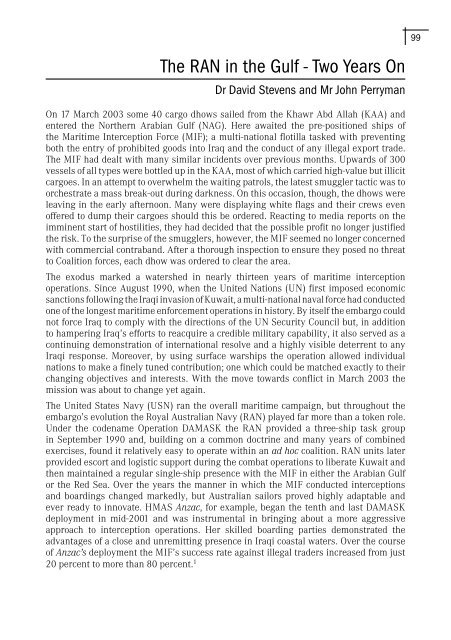Australian Maritime Issues 2005 - Royal Australian Navy
Australian Maritime Issues 2005 - Royal Australian Navy
Australian Maritime Issues 2005 - Royal Australian Navy
Create successful ePaper yourself
Turn your PDF publications into a flip-book with our unique Google optimized e-Paper software.
99<br />
The RAN in the Gulf - Two Years On<br />
Dr David Stevens and Mr John Perryman<br />
On 17 March 2003 some 40 cargo dhows sailed from the Khawr Abd Allah (KAA) and<br />
entered the Northern Arabian Gulf (NAG). Here awaited the pre-positioned ships of<br />
the <strong>Maritime</strong> Interception Force (MIF); a multi-national flotilla tasked with preventing<br />
both the entry of prohibited goods into Iraq and the conduct of any illegal export trade.<br />
The MIF had dealt with many similar incidents over previous months. Upwards of 300<br />
vessels of all types were bottled up in the KAA, most of which carried high-value but illicit<br />
cargoes. In an attempt to overwhelm the waiting patrols, the latest smuggler tactic was to<br />
orchestrate a mass break-out during darkness. On this occasion, though, the dhows were<br />
leaving in the early afternoon. Many were displaying white flags and their crews even<br />
offered to dump their cargoes should this be ordered. Reacting to media reports on the<br />
imminent start of hostilities, they had decided that the possible profit no longer justified<br />
the risk. To the surprise of the smugglers, however, the MIF seemed no longer concerned<br />
with commercial contraband. After a thorough inspection to ensure they posed no threat<br />
to Coalition forces, each dhow was ordered to clear the area.<br />
The exodus marked a watershed in nearly thirteen years of maritime interception<br />
operations. Since August 1990, when the United Nations (UN) first imposed economic<br />
sanctions following the Iraqi invasion of Kuwait, a multi-national naval force had conducted<br />
one of the longest maritime enforcement operations in history. By itself the embargo could<br />
not force Iraq to comply with the directions of the UN Security Council but, in addition<br />
to hampering Iraq’s efforts to reacquire a credible military capability, it also served as a<br />
continuing demonstration of international resolve and a highly visible deterrent to any<br />
Iraqi response. Moreover, by using surface warships the operation allowed individual<br />
nations to make a finely tuned contribution; one which could be matched exactly to their<br />
changing objectives and interests. With the move towards conflict in March 2003 the<br />
mission was about to change yet again.<br />
The United States <strong>Navy</strong> (USN) ran the overall maritime campaign, but throughout the<br />
embargo’s evolution the <strong>Royal</strong> <strong>Australian</strong> <strong>Navy</strong> (RAN) played far more than a token role.<br />
Under the codename Operation DAMASK the RAN provided a three-ship task group<br />
in September 1990 and, building on a common doctrine and many years of combined<br />
exercises, found it relatively easy to operate within an ad hoc coalition. RAN units later<br />
provided escort and logistic support during the combat operations to liberate Kuwait and<br />
then maintained a regular single-ship presence with the MIF in either the Arabian Gulf<br />
or the Red Sea. Over the years the manner in which the MIF conducted interceptions<br />
and boardings changed markedly, but <strong>Australian</strong> sailors proved highly adaptable and<br />
ever ready to innovate. HMAS Anzac, for example, began the tenth and last DAMASK<br />
deployment in mid-2001 and was instrumental in bringing about a more aggressive<br />
approach to interception operations. Her skilled boarding parties demonstrated the<br />
advantages of a close and unremitting presence in Iraqi coastal waters. Over the course<br />
of Anzac’s deployment the MIF’s success rate against illegal traders increased from just<br />
20 percent to more than 80 percent. 1

















